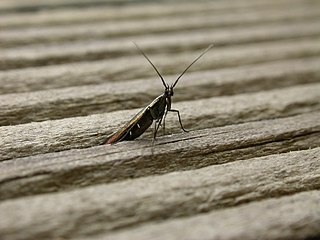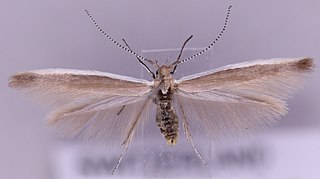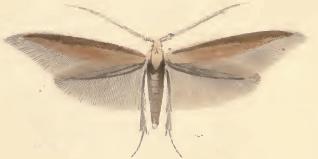
The Coleophoridae are a family of small moths, belonging to the huge superfamily Gelechioidea. Collectively known as case-bearers, casebearing moths or case moths, this family is represented on all continents, but the majority are found in temperate areas of the Northern Hemisphere. They are most common in the Palearctic, and rare in sub-Saharan Africa, South America, and Australia; consequently, they probably originated in northern Eurasia. They are relatively common in houses, they seek out moist areas to rest and procreate.

Coleophora is a very large genus of moths of the family Coleophoridae. It contains some 1,350 described species. The genus is represented on all continents, but the majority are found in the Nearctic and Palaearctic regions. Many authors have tried splitting the genus into numerous smaller ones, but most of these have not become widely accepted.

Aquilegia barbaricina, common name Barbaricina columbine, is a perennial species of flowering plant in the family Ranunculaceae. It is endemic to Italy, occurring only on the island of Sardinia.

Coleophora serratella is a moth of the family Coleophoridae. It is found in Europe, Japan (Hokkaido) and North America.

Coleophora limosipennella is a moth of the family Coleophoridae described by Philogène Auguste Joseph Duponchel in 1843. It is found in Europe from Fennoscandia to the Pyrenees, Italy and the Balkan Peninsula and from Great Britain to the Baltic States and Romania. It is an introduced species in North America.

Megalenhydris barbaricina is an extinct species of giant otter from the Late Pleistocene of Sardinia. It is known from a single partial skeleton, discovered in the Grotta di Ispinigoli near Dorgali, and was described in 1987. It was larger than any living otter, exceeding the size of South American giant otters (Petrolutra), which can reach two meters in length. The species is one of four extinct otter species from Sardinia and Corsica. The others are Algarolutra majori, Lutra castiglionis and Sardolutra ichnusae. It is suggested to have ultimately originated from the much smaller European mainland species "Lutra" simplicidens, which may be more closely related to Lutrogale than to modern Lutra species. The structure of the teeth points to a diet of bottom dwelling fish and crustaceans. A special characteristic of the species is the flattening of the first few caudal vertebrae. This might point to a slightly flattened tail.

Coleophora anatipennella is a moth of the case-bearer family (Coleophoridae).

Coleophora alcyonipennella, the clover case-bearer or small clover case-bearer, is a moth of the family Coleophoridae. It is native to Asia, Europe and North Africa, and has been introduced to Australia and New Zealand.

The metallic coleophora moth is a moth of the family Coleophoridae. It is native to Europe and Armenia, but is an adventive species in the Nearctic realm, where it is found throughout the United States and southern Canada. It has also been recorded from New Zealand, Chile and Argentina.

Coleophora albicostella is a moth of the family Coleophoridae. It is found from Latvia to the Iberian Peninsula, Italy, Greece and Cyprus.

Coleophora wockeella is a moth of the family Coleophoridae. It is found from Latvia to the Iberian Peninsula, Italy and Albania and from Great Britain to southern Russia.

Coleophora virgatella is a moth of the family Coleophoridae. It is found from Germany and Poland to the Pyrenees, Italy and Greece. It has also been recorded from southern Russia and central Asia.

Coleophora auricella is a moth of the family Coleophoridae. It is found from Germany and Poland to Spain, Italy and Romania. It has also been recorded from southern Russia.

Coleophora colutella is a moth of the family Coleophoridae. It is found in all of Europe, except Great Britain and Ireland. It is an introduced species in North America.

Coleophora cornutella is a moth of the family Coleophoridae. It is found from Fennoscandia to the Pyrenees and the Alps and from France to Romania.

Coleophora ledi is a moth of the family Coleophoridae. It is found from Fennoscandia and northern Russia to the Pyrenees and the Alps. In the east, it ranges to Japan. Outside of Eurasia, it is known from North America where it is found in eastern Canada, Michigan, and Alaska.

Coleophora ochripennella is a species of moth from the family Coleophoridae. It is found from Germany and Poland to the Pyrenees, Italy and Greece.
Coleophora oriolella is a moth of the family Coleophoridae. It is found in Germany and Poland to the Iberian Peninsula, Sardinia, Sicily and Greece and from France to southern Russia.

Coleophora clypeiferella is a moth of the family Coleophoridae. It is found from Fennoscandia to France, Austria, Hungary and Bulgaria and from Great Britain to Latvia, Lithuania and Ukraine. It is also known from the Caucasus and Ural regions of Russia and China. It occurs in steppe and cultivated areas.
Coleophora dianthi is a moth of the family Coleophoridae. It is found in most of Europe, Russia, Turkey and Iraq.











